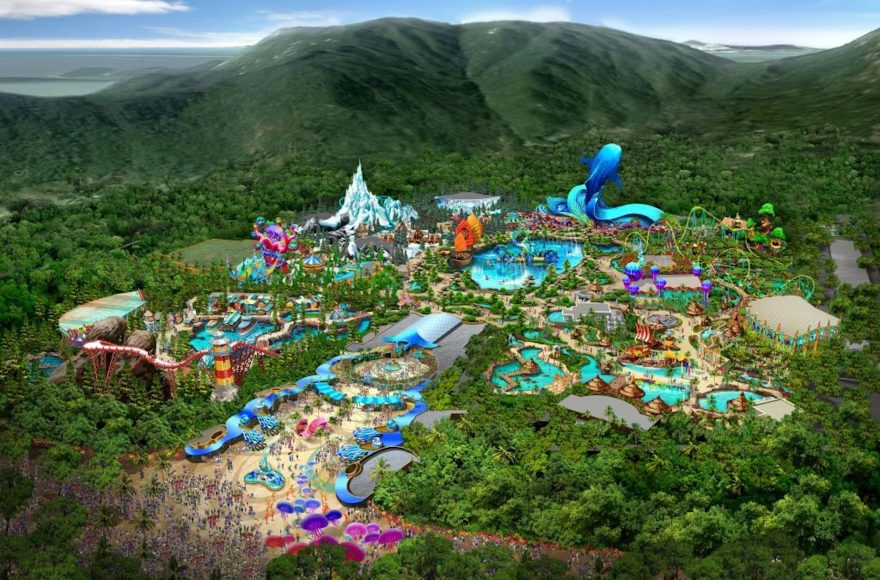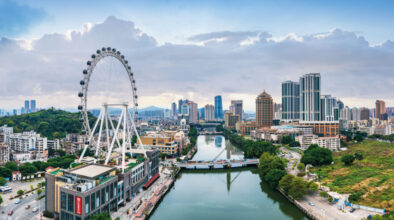On 20 November, 3,000 spectators will crowd into a brand new auditorium in Hengqin in Zhuhai for China’s first international circus festival, featuring 120 performers and 60 animals from 18 countries.
The curtain will rise not only on a circus to be held every day of the year but also China’s most ambitious tourist project – the Ocean Kingdom, involving an investment of 20 billion yuan by the Chimelong Group, a private company based in Guangzhou. The first of its ten theme parks is due to open at the end of this year.
It aims to attract 20 million visitors a year and surpass the resort which the Walt Disney company is building on 963 acres in the Pudong district of Shanghai, with a total investment of 29 billion yuan. It is due to open in December 2015.
“It will be the Orlando of China, and will become the new benchmark for the theme park industry,” said Su Zhigang, the chairman of Chimelong.
A first in Asia
It is the most ambitious tourism project ever undertaken by a Chinese company. Like Disney in Shanghai, it aims to attract not only millions of mainland visitors but also tourists from South Korea, Japan, India and other countries in Asia and further afield.
As foreigners go to the US to take their children to Disney World in Florida, so they will bring them to Ocean Kingdom – that is the hope of Su and his team at Chimelong.
It will be unlike anything in Asia – ten theme parks, 12 luxury theme hotels, three 18-hole golf courses, two yacht clubs, a science centre, shopping malls and an international convention centre. It will have the world’s largest aquarium window, through which visitors can see ten 40-foot-long whale sharks in a six-million-gallon tank; they are a threatened species and the world’s largest fish. There will be penguins, polar bears, spotted dolphins and Chinese white dolphins. The aim is to give visitors a close-up view of these marine creatures and a deeper understanding of their habitat.
“Ocean Kingdom’s role serves not only to entertain and to thrill, but also to bring the projected millions of annual visitors closer to marine animals and their stories. The immersive, high-tech, themed environments will bridge the often wide gap between humans and their underwater neighbours, generating a deeper understanding of these creatures and a call-to-action to join conservation efforts for them and their habitats,” said a statement by PGAV Destinations, the company based in St Louis, Missouri, that is the lead strategist, planner, designer and product developer for the project.
The plans for rides include the world’s tallest Ferris wheel at 210 metres high, a German-designed MACK water coaster, a MACK super splash and a ride through a rain forest with a bird’s eye view. Several large stadia will host marine performances by Beluga whales, dolphins, sea lions and walruses. There will be a cable car that circles the entire resort area. “It will allow guests to sit back and relax while enjoying the sea breeze and a full view of the ten theme parks, in the words of Chimelong.
The site will be home to the Chimelong Dolphin Hotel, with 1,888 rooms; the company calls it the “largest environmental hotel in China”, with rooms, restaurants and retail space built around water.
Big gamble
This spectacular investment represents an enormous gamble by Chimelong. The two main risks are access and whether visitors will come more than once.
Hengqin is an undeveloped island, with a population of about 10,000. In August 2009, the State Council approved it as a special economic district, the third in China after Pudong in Shanghai and Binhai in Tianjin. It covers 106 square kilometres, more than three times the size of neighbouring Macao.
Since 2009, the island has been the site of a construction boom, with workers racing to build roads, lay drainage pipes and telephone lines and complete the infrastructure needed for a modern city. The island aims to support a population of 280,000 by 2020.
Ocean Kingdom is on the bottom tip of Hengqin. The question is whether this infrastructure will be able to bring in and look after 20 million visitors a year to the new site; in other words, 55,000 people a day.
Shanghai Disney Resort will not have this problem. It sits in the southeast corner of Shanghai, a city with 24 million people and a sophisticated transport infrastructure already in place – airport, road and rail.
Chimelong is betting that tourists in Macao, Hong Kong and Guangdong will choose to spend an additional day or two in Hengqin. In 2012, 28 million visitors went to Macao, an increase of 0.3 percent over 2011; of them, 25 million were from the mainland, Hong Kong and Taiwan, up 0.4 percent, while the number of non-Chinese visitors fell 0.5 percent.
Guangdong itself is a major tourist market. It is one of the richest provinces in China and, in 2012, more than four million of its people went abroad for a holiday.
Of the mainland visitors to Macao, the majority passes through Zhuhai; they arrive by air, car, bus or the new high-speed train service from Guangzhou South station that started at the end of 2012. Many gamble in Macao but stay in hotels in Zhuhai, which are substantially cheaper than those across the border. Chimelong aims to persuade these visitors to extend their stay in the city in order to visit Ocean Kingdom.
Another element in its planning is the bridge being built between Hong Kong, Macao and Zhuhai, which is due to open in 2016 and will halve the travel time from the current 60–70 minutes.
For Ocean Kingdom to reach its ambitious targets, the transport system must be in place to deliver tens of thousands of visitors a day from Hong Kong, Macao and Guangdong and enable them to leave smoothly.
But the main ring road around Hengqin was completed only at the end of 2012. The basic infrastructure such as roads, telecommunications, gas and sewage pipelines are not all in place.
The other bet is that visitors will come more than once. Many theme parks in China have closed because they failed to persuade tourists to repeat their visits. Chimelong officials say they will change the shows and exhibits regularly, to attract people to come a second or third time.
Circus

It is fitting that Chimelong is starting its new resort with the circus. It has spent 300 million yuan on its circus city in Hengqin, with a total built-up area of 50,000 square metres; of this, 8,000 square metres house the circus pavilion, with seating for 3,000. The roof has been completed and the equipment is being installed for the festival, to run from 20 November until 1 December.
It is a national event, announced on 21 August in Beijing at a joint news conference hosted by the Ministry of Culture, the Guangdong provincial government, the Zhuhai city government and the Chimelong Group.
The circus festival chairman, He Ningka, who is also Mayor of Zhuhai, said that they had chosen 30 items from 18 countries, including China, Canada, Russia, France, the United States and Germany, with 150 performers and 60 animals, including horses and elephants.
After the festival is over, the venue will stage a circus every day of the year. The circus has been one of the secrets of success of Chimelong’s other main project – a tourist resort in Panyu, a suburb of Guangzhou. It includes ‘Chimelong Paradise’, an international circus, a safari, water and crocodile parks, hotels and restaurants.
The Panyu resort aims to attract 15 million visitors in 2013, compared to ten million in 2008; that would place it on a par with Greece, which ranks 17th in the world as a tourist destination and ahead of South Korea, which attracted 11.1 million foreign visitors last year. It was the success of the Panyu resort that enabled Chimelong to win the contract for Hengqin.
Think Big
For its Hengqin project, Chimelong hired major US design firms, PGAV Destinations and WATG, for two major parts of the project, the Ocean World and the Ocean Hotel.
Since its foundation in 1945 in Honolulu, Hawaii, WATG has become one of the world’s leading design consultants for the hospitality, leisure and entertainment industries. It has worked in 160 countries and territories across six continents, designing hotels and resorts, many of them in China. It aims to provide both design and sense of place and also commercial success.
PGAV worked on the Grand Aquarium in Hong Kong and the Terracotta Warriors Museum in Xian. It has created theme park attractions for Universal Studies, Six Flags, Sea World and Busch Gardens.
Hengqin’s place in the Delta
Ocean Kingdom will be the second major project to open in Hengqin. The first was the new campus of the University of Macau, built on a site nearby of 1.09 square kilometres at a cost of 9.8 billion patacas, which opened in September.
Chinese medicine as well as tourism. At present, it has 56 projects under way with a total investment of 226.3 billion yuan.
Most experts believe that, of these sectors, tourism is the most viable and that Hengqin can serve as a complement to Macao. While gambling is banned, it has spare land to build hotel complexes, golf courses, swimming pools, leisure centres and other facilities for which there is no space in Macao. “Gamble in Macao, relax in Hengqin” is the slogan.
In July this year, Shun Tak Holdings, the flagship of casino mogul Stanley Ho Hung-san, paid 721 million yuan for a site of 24,000 square metres in Hengqin; a few minutes from the Cotai Strip, the project will include offices, hotel accommodation, commercial space and service apartments.



